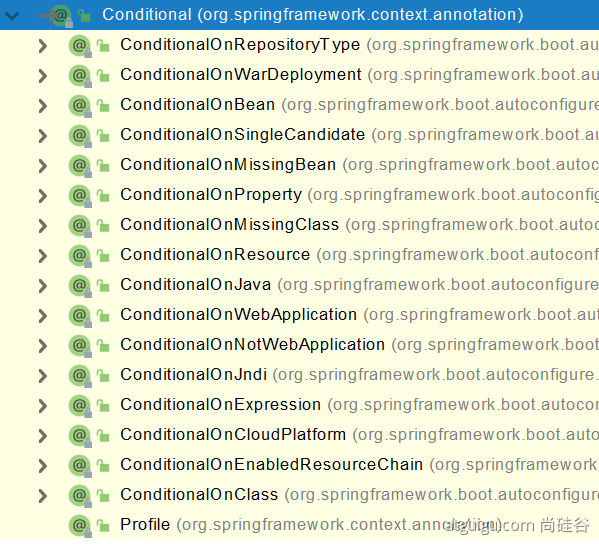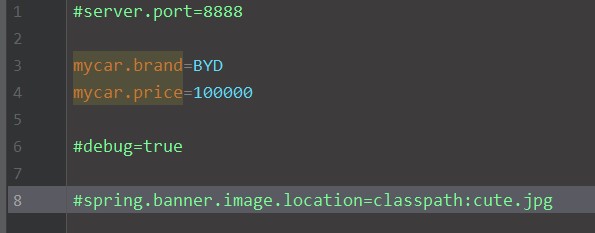2.1 组件添加
2.1.1 @Configuration
- 基本使用
- Full模式与Lite模式
- 配置 类组件之间无依赖关系用Lite模式加速容器启动过程,减少判断
配置类组件之间有依赖关系,方法会被调用得到之前单实例组件,用Full模式 ```java
#######################Configuration使用示例
/**
- 1、配置类里面使用@Bean标注在方法上给容器注册组件,默认也是单实例的
- 2、配置类本身也是组件
- 3、proxyBeanMethods:代理bean的方法
- Full(proxyBeanMethods = true)、【保证每个@Bean方法被调用多少次返回的组件都是单实例的】
- Lite(proxyBeanMethods = false)【每个@Bean方法被调用多少次返回的组件都是新创建的】
组件依赖必须使用Full模式默认。其他默认是否Lite模式 / @Configuration(proxyBeanMethods = false) //告诉SpringBoot这是一个配置类 == 配置文件 public class MyConfig {
/**
- Full:外部无论对配置类中的这个组件注册方法调用多少次获取的都是之前注册容器中的单实例对象
- @return */ @Bean //给容器中添加组件。以方法名作为组件的id。返回类型就是组件类型。返回的值,就是组件在容器中的实例 public User user01(){ User zhangsan = new User(“zhangsan”, 18); //user组件依赖了Pet组件 zhangsan.setPet(tomcatPet()); return zhangsan; }
@Bean(“tom”) public Pet tomcatPet(){ return new Pet(“tomcat”); } }
##########################@Configuration测试代码如下
@SpringBootConfiguration @EnableAutoConfiguration @ComponentScan(“com.atguigu.boot”) public class MainApplication {
public static void main(String[] args) {//1、返回我们IOC容器ConfigurableApplicationContext run = SpringApplication.run(MainApplication.class, args);//2、查看容器里面的组件String[] names = run.getBeanDefinitionNames();for (String name : names) {System.out.println(name);}//3、从容器中获取组件Pet tom01 = run.getBean("tom", Pet.class);Pet tom02 = run.getBean("tom", Pet.class);System.out.println("组件:"+(tom01 == tom02));//4、com.atguigu.boot.config.MyConfig$$EnhancerBySpringCGLIB$$51f1e1ca@1654a892MyConfig bean = run.getBean(MyConfig.class);System.out.println(bean);//如果@Configuration(proxyBeanMethods = true)代理对象调用方法。SpringBoot总会检查这个组件是否在容器中有。//保持组件单实例User user = bean.user01();User user1 = bean.user01();System.out.println(user == user1);User user01 = run.getBean("user01", User.class);Pet tom = run.getBean("tom", Pet.class);System.out.println("用户的宠物:"+(user01.getPet() == tom));}
}
<a name="y1e0Q"></a>
### 2.1.2 @Bean、@RestController
1、@Bean
- 给容器中添加组件。以方法名作为组件的id。返回类型就是组件类型。返回的值,就是组件在容器中的实例
- 可以修改@Bean的value值作为指定组件的id
```java
@Configuration(proxyBeanMethods = false) //告诉SpringBoot这是一个配置类 == 配置文件
public class MyConfig {
/**
* Full:外部无论对配置类中的这个组件注册方法调用多少次获取的都是之前注册容器中的单实例对象
* @return
*/
@Bean //给容器中添加组件。以方法名作为组件的id。返回类型就是组件类型。返回的值,就是组件在容器中的实例
public User user01(){
User zhangsan = new User("zhangsan", 18);
//user组件依赖了Pet组件
zhangsan.setPet(tomcatPet());
return zhangsan;
}
@Bean("tom")
public Pet tomcatPet(){
return new Pet("tomcat");
}
}
原生的在配置文件创建组件方法对比:
======================beans.xml========================= <?xml version="1.0" encoding="UTF-8"?> <beans xmlns="http://www.springframework.org/schema/beans" xmlns:xsi="http://www.w3.org/2001/XMLSchema-instance" xmlns:context="http://www.springframework.org/schema/context" xsi:schemaLocation="http://www.springframework.org/schema/beans http://www.springframework.org/schema/beans/spring-beans.xsd http://www.springframework.org/schema/context https://www.springframework.org/schema/context/spring-context.xsd"> <bean id="user01" class="com.atguigu.boot.bean.User"> <property name="name" value="zhangsan"></property> <property name="age" value="18"></property> </bean> </beans>2、@RestController
由@Controller和@ResponseBody组合而成
2.1.3 @ComponentScan、@Import
@ComponentScan 指定扫描路径
@SpringBootApplication
等同于
@SpringBootConfiguration
@EnableAutoConfiguration
@ComponentScan("com.atguigu.boot")
@Import
* @Import({User.class, DBHelper.class})
* 给容器中自动创建出这两个类型的组件、默认组件的名字就是全类名
*
*
*
*/
@Import({User.class, DBHelper.class})
@Configuration(proxyBeanMethods = false) //告诉SpringBoot这是一个配置类 == 配置文件
public class MyConfig {
}
2.1.4 @Conditional
条件装配:满足Conditional指定的条件,则进行组件注入
- @ConditionalOnBean(name = “tom”):当容器中含有id=”tom”的组件时才运行代码执行
- @ConditionalOnMissingBean(name = “tom”):当容器中不含有id=”tom”的组件时才运行代码执行 ```java =====================测试条件装配========================== @Configuration(proxyBeanMethods = false) //告诉SpringBoot这是一个配置类 == 配置文件 //@ConditionalOnBean(name = “tom”) @ConditionalOnMissingBean(name = “tom”) public class MyConfig {
/**
* Full:外部无论对配置类中的这个组件注册方法调用多少次获取的都是之前注册容器中的单实例对象
* @return
*/
@Bean //给容器中添加组件。以方法名作为组件的id。返回类型就是组件类型。返回的值,就是组件在容器中的实例
public User user01(){
User zhangsan = new User("zhangsan", 18);
//user组件依赖了Pet组件
zhangsan.setPet(tomcatPet());
return zhangsan;
}
@Bean("tom22")
public Pet tomcatPet(){
return new Pet("tomcat");
}
}
<a name="HB6xQ"></a>
## 2.2 原生配置文件引入
<a name="yUfdb"></a>
### 2.2.1 @ImportResource
```xml
======================beans.xml=========================
<?xml version="1.0" encoding="UTF-8"?>
<beans xmlns="http://www.springframework.org/schema/beans"
xmlns:xsi="http://www.w3.org/2001/XMLSchema-instance"
xmlns:context="http://www.springframework.org/schema/context"
xsi:schemaLocation="http://www.springframework.org/schema/beans http://www.springframework.org/schema/beans/spring-beans.xsd http://www.springframework.org/schema/context https://www.springframework.org/schema/context/spring-context.xsd">
<bean id="haha" class="com.atguigu.boot.bean.User">
<property name="name" value="zhangsan"></property>
<property name="age" value="18"></property>
</bean>
<bean id="hehe" class="com.atguigu.boot.bean.Pet">
<property name="name" value="tomcat"></property>
</bean>
</beans>
@Configuration(proxyBeanMethods = false)
@ImportResource("classpath:beans.xml")
public class MyConfig {}
======================测试=================
boolean haha = run.containsBean("haha");
boolean hehe = run.containsBean("hehe");
System.out.println("haha:"+haha);//true
System.out.println("hehe:"+hehe);//true
2.3 配置绑定
如何使用Java读取到properties文件中的内容,并且把它封装到JavaBean中,以供随时使用;
public class getProperties {
public static void main(String[] args) throws FileNotFoundException, IOException {
Properties pps = new Properties();
pps.load(new FileInputStream("a.properties"));
Enumeration enum1 = pps.propertyNames();//得到配置文件的名字
while(enum1.hasMoreElements()) {
String strKey = (String) enum1.nextElement();
String strValue = pps.getProperty(strKey);
System.out.println(strKey + "=" + strValue);
//封装到JavaBean。
}
}
}
2.3.1 @ConfigurationProperties
- @ConfigurationProperties需要与@Component一起使用才能生效

@ConfigurationProperties(prefix = “mycar”)作用是将配置文件中mycar前缀的属性赋值到Car类中
/** * 只有在容器中的组件,才会拥有SpringBoot提供的强大功能 */ @Component @ConfigurationProperties(prefix = "mycar") public class Car { private String brand; private Integer price; public String getBrand() { return brand; } public void setBrand(String brand) { this.brand = brand; } public Integer getPrice() { return price; } public void setPrice(Integer price) { this.price = price; } @Override public String toString() { return "Car{" + "brand='" + brand + '\'' + ", price=" + price + '}'; } }2.3.2 @EnableConfigurationProperties
在配置类中使用了@EnableConfigurationProperties(Car.class)后Car类就不用写@Component
@Configuration(proxyBeanMethods = false) @EnableConfigurationProperties(Car.class) //1、开启Car配置绑定功能 //2、把这个Car这个组件自动注册到容器中 public class MyConfig { }2.3.3 @Value
通过${}可以获取对应yaml里的值,冒号后面写的值的作用是当在配置文件找不到对应的值时就用冒号后面的值。
@RestController public class HelloController { @Value("${person.name:小明}") private String name; @Autowired Person person; @GetMapping("/") public String hello(){ return person.getClass().toString(); } }person.name=hao

